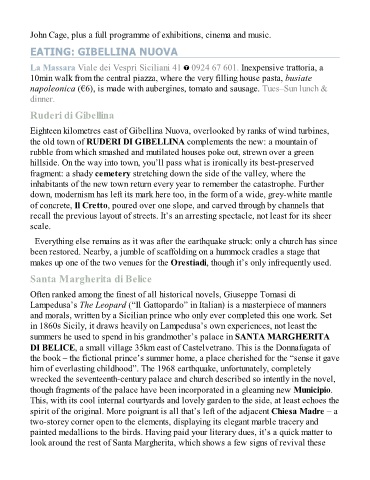Page 544 - The Rough Guide of Sicily
P. 544
John Cage, plus a full programme of exhibitions, cinema and music.
EATING: GIBELLINA NUOVA
La Massara Viale dei Vespri Siciliani 41 0924 67 601. Inexpensive trattoria, a
10min walk from the central piazza, where the very filling house pasta, busiate
napoleonica (€6), is made with aubergines, tomato and sausage. Tues–Sun lunch &
dinner.
Ruderi di Gibellina
Eighteen kilometres east of Gibellina Nuova, overlooked by ranks of wind turbines,
the old town of RUDERI DI GIBELLINA complements the new: a mountain of
rubble from which smashed and mutilated houses poke out, strewn over a green
hillside. On the way into town, you’ll pass what is ironically its best-preserved
fragment: a shady cemetery stretching down the side of the valley, where the
inhabitants of the new town return every year to remember the catastrophe. Further
down, modernism has left its mark here too, in the form of a wide, grey-white mantle
of concrete, Il Cretto, poured over one slope, and carved through by channels that
recall the previous layout of streets. It’s an arresting spectacle, not least for its sheer
scale.
Everything else remains as it was after the earthquake struck: only a church has since
been restored. Nearby, a jumble of scaffolding on a hummock cradles a stage that
makes up one of the two venues for the Orestiadi, though it’s only infrequently used.
Santa Margherita di Belice
Often ranked among the finest of all historical novels, Giuseppe Tomasi di
Lampedusa’s The Leopard (“Il Gattopardo” in Italian) is a masterpiece of manners
and morals, written by a Sicilian prince who only ever completed this one work. Set
in 1860s Sicily, it draws heavily on Lampedusa’s own experiences, not least the
summers he used to spend in his grandmother’s palace in SANTA MARGHERITA
DI BELICE, a small village 35km east of Castelvetrano. This is the Donnafugata of
the book – the fictional prince’s summer home, a place cherished for the “sense it gave
him of everlasting childhood”. The 1968 earthquake, unfortunately, completely
wrecked the seventeenth-century palace and church described so intently in the novel,
though fragments of the palace have been incorporated in a gleaming new Municipio.
This, with its cool internal courtyards and lovely garden to the side, at least echoes the
spirit of the original. More poignant is all that’s left of the adjacent Chiesa Madre – a
two-storey corner open to the elements, displaying its elegant marble tracery and
painted medallions to the birds. Having paid your literary dues, it’s a quick matter to
look around the rest of Santa Margherita, which shows a few signs of revival these

